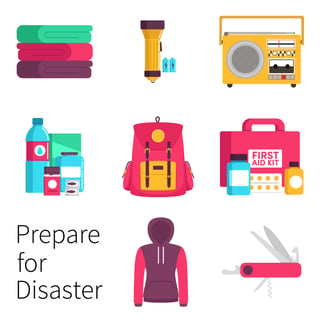Prep for Disaster

A Disaster is defined as a sudden event, such as an accident or a natural catastrophe that causes great damage or loss of life. It can be hard to imagine how you could go about preparing for something that could happen at a moment’s notice without warning. Sadly, when we look at the conditions of the world around us and see the current headlines, this is a reality we must face. So the question arises, is there anything we can do to prepare to minimize property damage but also what can we do to protect ourselves and our families?
I received a recent publication that outlines some steps that we can take to prepare for disasters. There are some keys to preparation. First, we want to prepare mentally; we need to acknowledge the fact that disasters do happen and they can happen, even to us! If you wait for a disaster to come your way then it will be too late to prepare. You will also want to learn about the disasters that can affect you and that are common in your area. Learn what you can do to prepare your home for the disasters that are common to your area. To prepare to protect your family, prep some emergency supplies. Remember, power, water, phone and transportation services can fail so you will want to have other options available to you in the case of a disaster. If you have a vehicle, try to keep your tank at least half full and always have food, water and an emergency kit in your home.
The article, “When Disaster Strikes- Steps That Can Save Lives”, the following is stated:
In general, it is recommended that you keep at least three gallons (11 L) of water per person and three days of nonperishable, ready-to-eat foods. Also, some families have prepared “go bags” with such items as the following:
- Blankets, complete change of warm clothes, and sturdy shoes
- Flashlight, radio (battery or windup), and spare batteries
- First-aid kit and a whistle to signal for help
- Eating utensils, can opener, pocket tool set, and waterproof matches
- Dust masks, waterproof tape, and plastic sheeting for shelter
- Toothbrushes, soap, towels, and toilet paper
- Child-care supplies and special-needs items for seniors or the disabled
- A waterproof container with needed medication, copies of prescriptions, and other important documents
- List of emergency contacts and meeting places and a local map
- Credit cards and cash
- Extra set of house keys and car keys
- Paper, pencils, books, and games for children
They go on to say, “Disaster management organizations urge families to store and annually update emergency supplies. Of course, needs will vary according to your location and circumstances, so check with local emergency management services for recommendations that could be applied in your area.”
We want to do everything we can to keep our families safe in case of an emergency, after all isn’t that at least part of the reason why you become a homeowner to begin with? You wanted to provide your family with a place that they could have a sense of security.
If you aren’t a homeowner and considering finding a home for your family please contact us to find out what steps you can take to make this dream come true! Just visit www.smcapproved.com and find a mortgage banker that is near you; you can work with one remotely of course but it’s kind of fun to run into them at your local Kroger! If you can’t decide on who to work with give us a call at our main number and we will put you in touch with someone!
If you would like to learn more about steps you can take during and after a disaster, please take a moment to read the rest of our source article here: https://www.jw.org/en/publications/magazines/awake-no5-2017-october/disaster-steps-that-can-save-lives/
